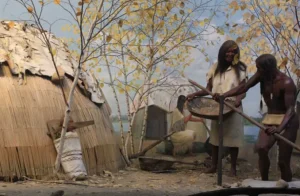Early manifestations of collective government and democratic cooperation were documented in the form of round council houses.

Democracy may have existed in some Native American societies long before Europeans arrived on the continent, according to a new peer-reviewed study released by the Cambridge University Press from the University of Georgia.
The study identified large, round houses with evidence of community meetings for the purpose of collective decision-making.
Reviewing old data
US archeologists re-evaluated the data from an excavation over 40 years ago from a Cold Springs site in Georgia. Previously, it was believed that the mounds made of different sediments constituted the foundation for a chief’s quarters, and that most communities in the area followed the political style of chiefdom; a form of social organization based on inherited political power.
However, this study suggests it is much more likely that chiefdom was not the form of government at that site. The construction of the mounds indicates a more community-based political organization than a hierarchal one.
The Muskogean council
The area is connected to the ancestral Muskogean council, a still-active group with participants of both men and women. Guided by two principles, natural law and democratic consensus, the Muskogean government is one of the oldest inclusive democratic groups in history.

Natural law refers to the laws that bind the relationship of culture and nature, rooted in community and oral tradition. Democratic consensus involved community decision-making in places like the council house.
Council houses are large, round buildings anywhere from 12-37 meters in diameter and could hold up to thousands of people. Developed after the sediment mounds, though sometimes built on top of them, it is part of the communal landscape. It was custom to hold assemblies for those who recognized they were united to the council house and the community.
Dated prior to 1000 AD, the council houses indicate forms of collective democracy being used among Indigenous Americans over 1500 years ago – before any European contact.
Ceramic vessels found indicate that often food or drink, such as the ceremonial tea called vsse [ássi], were consumed during these meetings. In part a bridge to the ceremonial world and in part a place for government functions, similar vessels are still used today for traditional gatherings.
Small fire pits also indicate the use of the houses. Often the location of the house was close to an open plaza or other public places.
The finding indicates decision-making on multiple levels, with the democratic consensus being reached through a process of consent with different sectors of the community.
“Council houses were the early manifestations of a form of collective governance that can be confidentially documented in one form over another,” the study says.
Due to the large capacity the houses hold, the study argues it was explicitly a social institution and a key part of the government in that region, requiring roles and labour and catering to the specific needs of the community.
Ancient democracy
Taking issue with the term egalitarianism that many anthropologists use, the study argues that democracy and collective governance are the correct terms to fully capture the complex sophistication of Indigenous government. The archaeologists suggest that given the forum for community discussion, the resolution of any issues threatening their democracy were solved quickly.
Ceramics and radiocarbon dating places both the sediment mounds and council houses prior to 1000 AD, with some much earlier than that. Posts and supports dated later than the original building suggests upkeep and the importance of the tradition to the community.
The study stresses that this dating indicates core traditions based in oral tradition and history – and recommends archeology be more willing to use oral history in their research.

